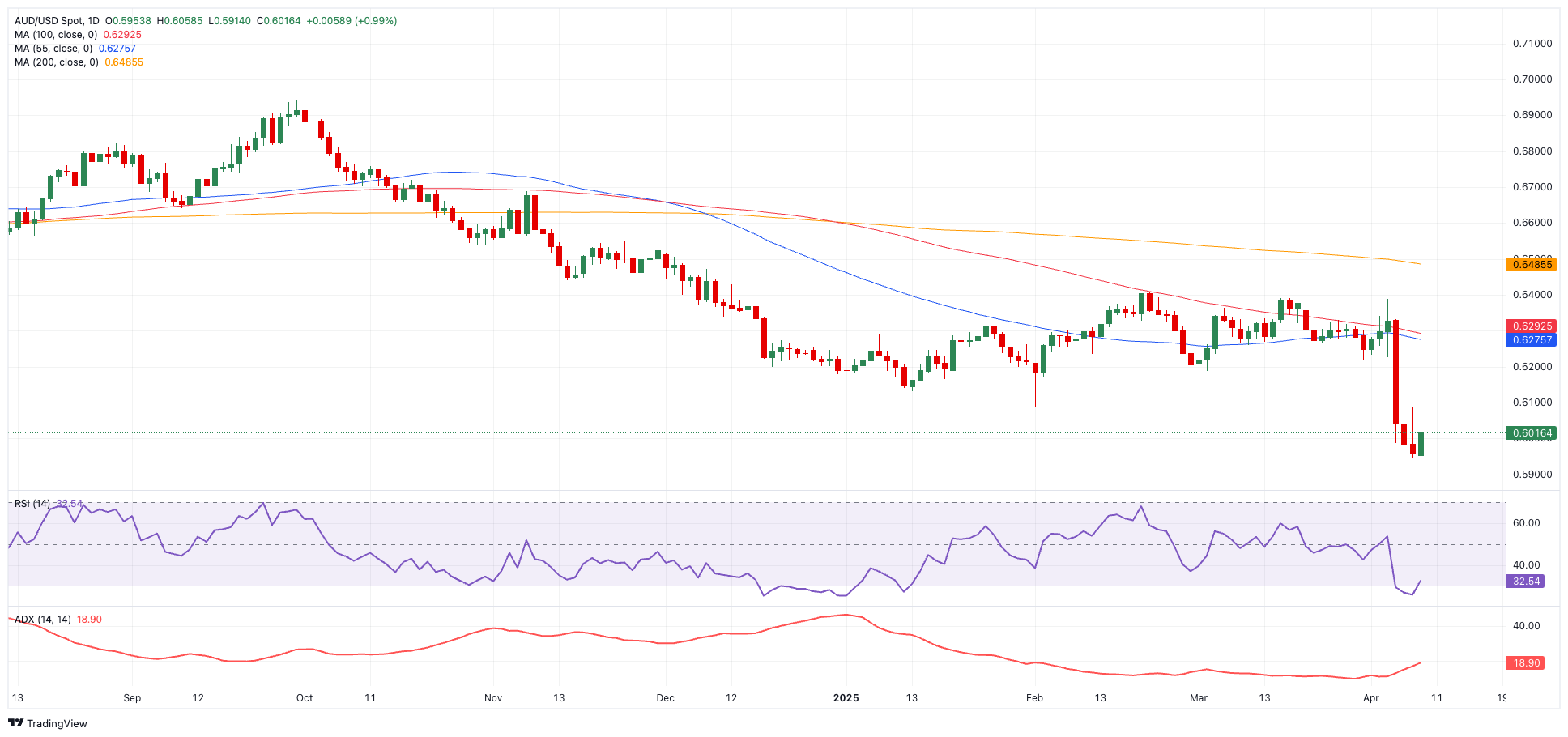- AUD/USD regained composure after a drop to the vicinity of 0.5900.
- The US Dollar dropped markedly on the back of jitters around the US economy.
- Chinese 84% levies on US goods will kick in on April 10.
The Australian Dollar (AUD) managed a decent comeback on Wednesday after taking a hefty hit over the past three days.
In fact, AUD/USD regained the psychological 0.6000 mark and beyond, recovering from earlier new multi-year lows near the 0.5900 support, its weakest level since March 2020.
This rebound came primarily on the back of a much weaker US Dollar (USD) on the back of mounting concerns over the economic impact of President Trump’s tarde policies.
Global trade tensions heat up
In a dramatic move, President Trump introduced tariffs ranging from 10% to 50%, triggering swift countermeasures and ratcheting up fears of a global trade war. Such an escalation could weigh on global growth, boost consumer prices, and complicate monetary policies worldwide.
Australia, given its strong economic ties with China—especially in commodities—finds its currency directly exposed to any slowdown in Chinese demand or collateral damage from US-imposed tariffs. Markets got a stark reminder of that last week when China countered with its own tariffs, sending AUD/USD to multi-year lows.
Doubling down on the showdown, Trump’s 104% tariffs on China kicked in today, while China’s 84% retaliatory tariffs on US goods are due on Thursday, all motivating the trade effervescence to swell.
Fed treads carefully
Stateside, the Federal Reserve (Fed) finds itself caught between rising trade strains, which could drive inflation higher, and signs of a moderating US economy. In March, the Fed held its benchmark rate at 4.25–4.50%, opting to watch and wait.
Last Friday, Fed Chair Jerome Powell conceded that new tariffs may have a bigger impact on inflation and growth than anticipated. Going forward, the Fed’s actions will likely be dictated by ongoing trade developments.
RBA stands pat amid uncertainty
Meanwhile, the Reserve Bank of Australia (RBA) left its Official Cash Rate (OCR) unchanged at 4.10% on Tuesday, as widely predicted. Policymakers scrapped earlier hints of additional easing, highlighting risks on both the upside and downside of the economic spectrum.
RBA Governor Michele Bullock underscored the challenge of bringing inflation back to the 2–3% band and confirmed a unanimous vote to keep policy on hold. The market responded by lowering the odds of a 25-basis-point rate cut at the May 20 meeting from 80% to 70%.
Bearish sentiment swirls around the Aussie
Traders remain wary of the Australian Dollar. The latest CFTC data shows net shorts hovering near multi-month highs at around 76K contracts, reflecting persistent tariff concerns and ongoing caution toward the Aussie.
AUD/USD technical landscape
From a technical standpoint, as long as the pair stays below its 200-day Simple Moving Average (SMA) near 0.6490, the bias remains tilted to the downside. Renewed selling pressure could drive the pair back toward its recent 2025 trough at 0.5913 (April 8), and even challenge the 2020 bottom at 0.5506 (March 19).
On the flip side, a break above the 2025 high at 0.6408 (February 21) could open the door for a test of the 200-day SMA at 0.6489, and potentially the November 2024 top at 0.6687.
While the Relative Strength Index (RSI) bouncing toward the 33 level, the Average Directional Index (ADX) near 18 suggests the overall trend is still quite soft, despite a slight rebound.
AUD/USD daily chart

The road ahead
The Melbourne Institute’s Inflation Expectations will be published on April 10.
Bottom line
The fate of the Australian Dollar hinges on how intensifying trade conflicts play out, the health of China’s economy, and shifting monetary policies in both Australia and the US. With stakes rising, the Aussie will be quick to respond to any trade news or policy surprises in the weeks ahead.
Information on these pages contains forward-looking statements that involve risks and uncertainties. Markets and instruments profiled on this page are for informational purposes only and should not in any way come across as a recommendation to buy or sell in these assets. You should do your own thorough research before making any investment decisions. FXStreet does not in any way guarantee that this information is free from mistakes, errors, or material misstatements. It also does not guarantee that this information is of a timely nature. Investing in Open Markets involves a great deal of risk, including the loss of all or a portion of your investment, as well as emotional distress. All risks, losses and costs associated with investing, including total loss of principal, are your responsibility. The views and opinions expressed in this article are those of the authors and do not necessarily reflect the official policy or position of FXStreet nor its advertisers. The author will not be held responsible for information that is found at the end of links posted on this page.
If not otherwise explicitly mentioned in the body of the article, at the time of writing, the author has no position in any stock mentioned in this article and no business relationship with any company mentioned. The author has not received compensation for writing this article, other than from FXStreet.
FXStreet and the author do not provide personalized recommendations. The author makes no representations as to the accuracy, completeness, or suitability of this information. FXStreet and the author will not be liable for any errors, omissions or any losses, injuries or damages arising from this information and its display or use. Errors and omissions excepted.
The author and FXStreet are not registered investment advisors and nothing in this article is intended to be investment advice.
Recommended Content
Editors’ Picks

Gold clings to gains around $3,430
Gold fell from its previous record high of $3,500 per troy ounce, as overbought indications and a comeback in the US dollar appear to have led purchasers to take a break. Meanwhile, all eyes are on the Trump-Powell frenzy and impending Fed officials' statements.

EUR/USD trims losses, retargets 1.1500 and beyond
EUR/USD now bounces off daily troughs near 1.1460 and refocuses back on the 1.1500 barrier amid some humble knee-jerk in the US Dollar. In the meantime, markets remain cautious in light of President Trump’s criticism of Fed Chair Jerome Powell and its potential implications for the US markets.

GBP/USD treads water below 1.3400
GBP/USD is trading in a narrow zone below the 1.3400 level as the Greenback's solid comeback gains traction on Tuesday. However, continuing concerns about a US economic downturn and misgivings about the Fed's independence are anticipated to limit Cable's downside risk.

3% of Bitcoin supply in control of firms with BTC on balance sheets: The good, bad and ugly
Bitcoin disappointed traders with lackluster performance in 2025, hitting the $100,000 milestone and consolidating under the milestone thereafter. Bitcoin rallied past $88,000 early on Monday, the dominant token eyes the $90,000 level.

Five fundamentals for the week: Traders confront the trade war, important surveys, key Fed speech Premium
Will the US strike a trade deal with Japan? That would be positive progress. However, recent developments are not that positive, and there's only one certainty: headlines will dominate markets. Fresh US economic data is also of interest.

The Best brokers to trade EUR/USD
SPONSORED Discover the top brokers for trading EUR/USD in 2025. Our list features brokers with competitive spreads, fast execution, and powerful platforms. Whether you're a beginner or an expert, find the right partner to navigate the dynamic Forex market.